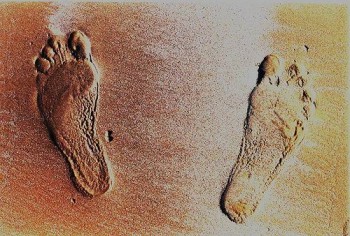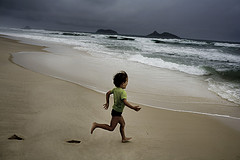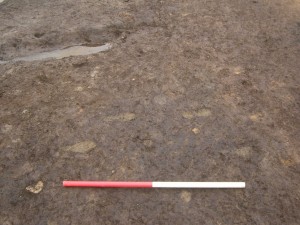 I love unguarded moments, those brief seconds when someone on stage or in front of a camera finally gives way to nervousness and says or does something completely unplanned and unrehearsed, something that just spills out like a stream overtaking its banks. For a moment, we see something that we weren’t meant to, something revealing, something truthful, something charming, and we smile in delight at this most human of connections.
I love unguarded moments, those brief seconds when someone on stage or in front of a camera finally gives way to nervousness and says or does something completely unplanned and unrehearsed, something that just spills out like a stream overtaking its banks. For a moment, we see something that we weren’t meant to, something revealing, something truthful, something charming, and we smile in delight at this most human of connections.
It may sound strange but I look for traces of unguarded moments all the time when I am wandering prehistoric sites. So much of archaeology is the public face of our human ancestors: the carefully planned stone wall, the polished sherd, the delicately chipped edge of a projectile point. But every once in a while archaeologists catch a glimpse of something else, something that has the spark of life. And often it’s where you might least expect it–running along on the ground in the humble indentations of human footprints.
Just last week, the British press carried a wonderful story about the discovery of a Roman child’s footprints in a site in northern England destined to become part of an upgraded A1 highway.  In Roman times, the site lay just outside a frontier garrison of the Ninth Legion, a legendary fighting unit thought by some to have been massacred almost to a man during a foray into the northern lands of the Picts. (If this plot sounds familiar, you’ve probably just seen The Eagle, a cinematic retelling of the story now in the theaters.)
In Roman times, the site lay just outside a frontier garrison of the Ninth Legion, a legendary fighting unit thought by some to have been massacred almost to a man during a foray into the northern lands of the Picts. (If this plot sounds familiar, you’ve probably just seen The Eagle, a cinematic retelling of the story now in the theaters.)
But long before any such a gruesome defeat, a child slipped out from the Ninth Legion’s garrison to play along the stream. The ground there was muddy and wet, so wet in fact that someone from the outpost had scattered plant material and laid stones across the spot to keep sandals and socks dry. (Yes, the Romans really did wear socks under their sandals to stay warm: a year ago, archaeologists found new evidence for socks in Roman graves located outside the same garrison, known today as the Healam Bridge Roman Fort.)
 The child, in question, however, seems to have regarded this wetland as a playground. He or she skipped along it, leaving a series of well-preserved footprints in the mud that later hardened and became covered by layers of sediments. The Highway Agency archaeological team who uncovered these foot-shaped holes marveled: the small trackway could be read as a little film. “The child was probably running through the mud, jumping in puddles or possibly just trying to avoid getting their feet wet,” team member Helen Maclean told Sky News. I can see it all so clearly.
The child, in question, however, seems to have regarded this wetland as a playground. He or she skipped along it, leaving a series of well-preserved footprints in the mud that later hardened and became covered by layers of sediments. The Highway Agency archaeological team who uncovered these foot-shaped holes marveled: the small trackway could be read as a little film. “The child was probably running through the mud, jumping in puddles or possibly just trying to avoid getting their feet wet,” team member Helen Maclean told Sky News. I can see it all so clearly.
And archaeologists elsewhere have stumbled on equally revealing trackways of youthful abandon. Along the damp edges of Australia’s Willandra Lakes, researchers discovered nearly 500 footprints meandering in more than 25 trackways. Not all are human–wandering emus and marsupials contributed their fair share—but most belong to a group of several adult humans, adolescents and children who hurried along the lakeshore in an eastward direction some 20,000 years ago.
The youngest walker in the group was somewhere between two and four years old, judging from the 15-cm-long footprints cutting across what was then rain-dampened volcanic ash. And she seems to have been in a defiant mood, judging from the location of the footprints and the stride length. While the rest of the party hurried onwards, the child stopped, pivoted about and ran off in the opposite direction. Then the young rebel wheeled around and marched briskly back to the group, as if one of the adults had insisted that the child return.
“Perhaps the child was called back by an adult or older sibling,” wrote archaeologists Harvey Johnston and Michael Westaway, of this evocative find. Then the pair vouchsafed a personal reflection. “So seldom in open-site archaeology do we see such a personal and familiar signature.”
I hear a deep sigh buried in those words.
Photos: Top. Footprints, courtesy P.J.P. (Pejman Parvandi); Middle: Boy running on sand, courtesy Cia de Foto. Bottom: Roman child’s footprints at Healam Bridge Roman Fort site. Courtesy Northern Archaeological Associates.
“For a moment, we see something that we weren’t meant to, something revealing, something truthful, something charming, and we smile in delight at this most human of connections.”
What a beautiful words, I’m moved by them.
Heather Pringle, I always found your articles thoughtful and really well written.
Mary.
Love this post. Reminded me of the quote “Life is not measured by the number of breaths we take;But by the moments that take our breath away.”